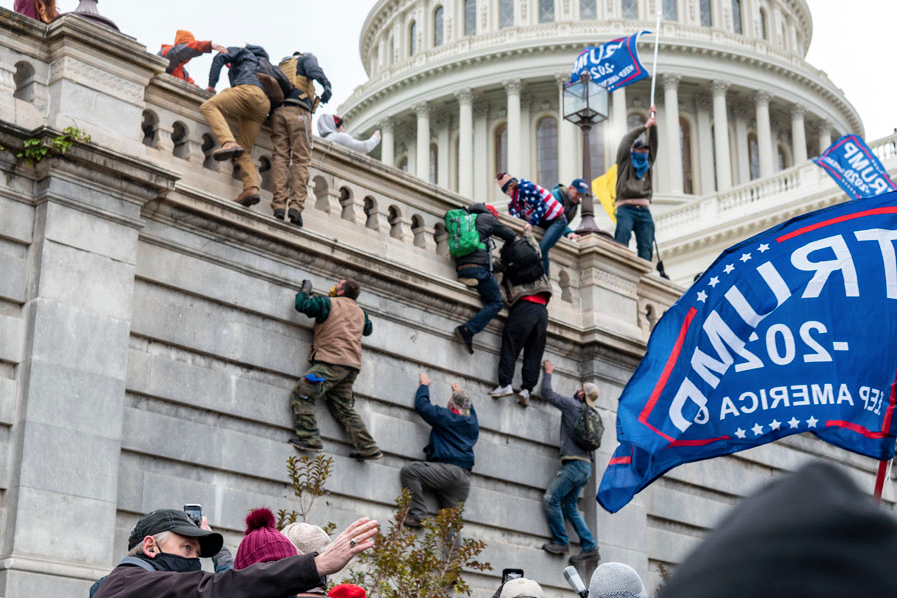The invasion of the Capitol by former President Donald Trump on the basis of electoral fraud has been described by many journalists and political analysts as the biggest attack on democracy in the United States. The supposedly exceptional event in the history of the United States was compared to something routine in the Latin American scenario.
The invasion led former President George W. Bush to associate the resulting images of chaos with those typical of “a banana republic.” Such analogies were refuted by former Secretary of State Mike Pompeo, who said: “This slander reveals a mistaken understanding of banana republics and democracy in the United States.
While disagreeing with each other as to the relevance of comparing the episode to those taking place in Latin America, Bush and Pompeo used the term “Banana Republic” in its usual pejorative sense. The term was coined by the American writer known by the pseudonym O. Henry in the short story “The Admiral,” in the early 20th century, to refer to Anchuria, a fictional country inspired by Honduras, to which the author fled after being accused of bank embezzlement.
Since then, the term has grown to include Latin American countries with unstable political institutions, dominated by corruption, violence and a situation of deep international economic dependence.
The “Banana Republic” alludes, in Bush and Pompeo’s speeches, to a place metaphorically distant from the United States, of institutional and moral decay, supposedly foreign to American democracy, which projects itself into the world as solid and exemplary. In fact, the US democracy has designated itself as a norm-setter for the other democracies of the continent, which are considered as fragile and minimally institutionalized. Deviations, such as the Cuban or Venezuelan deviations, are punished by non-recognition, blockades, sanctions and suspension of international institutions.
However, what Bush and Pompeo’s narrative silences is that the history of institutional instability, brutality and coups in Latin America is not a history apart from that of the United States, it is not the history of the United States inside out, but is a central part of its history.
Trump’s self-coup is familiar because it takes us back to the traditional U.S. foreign policy of fostering anti-democratic policies, political and economic destabilization in Latin America. Examples abound throughout Latin America’s history of U.S. military interventions to overthrow governments contrary to their economic and security interests, of military and economic assistance to perpetuate authoritarian regimes, or of encouraging opposition groups to depose constitutionally elected governments.
If we take into account this other history of the United States as an imperialist power in Latin America, the invasion of the Capitol does not cause so much strangeness. In contrast, it can be seen as the result of a boomerang effect, as Aimé Césaire put it when referring to the Nazi experience. The Antilles poet points out that before being victims of racism with the advent of Nazi regimes, the Europeans were accomplices, because they tolerated, legitimized and acquitted racist practices in the colonial domains before they impacted them.
The question remains: to what extent was the United States not complicit in coups, in the destruction of ecosystems, in the production of inequalities in Latin America before the Trumpist coup impacted them? In other words, it is as if the incitement of coups, a practice so close to the United States’ foreign policy on Latin America, had inadvertently migrated into American territory. Far from being an aberration or anomaly in the history of the United States, both the incitement of the coups and the racialization of Latin America that underpinned them are firmly inscribed in the history of the country.
In the racist contours of Trump’s imagination and of his supporters, democratic pacts should not extend to all the Americas. The Trumpist narrative of making America great again contradictorily amounted to appeasing it, to defending a narrow, white, heteronormative America, trying to fight the Latinization of America with all its might.
Although the former president failed to make his main political project of building an “impenetrable physical” wall separating the borders of the United States and Mexico viable, Americans were summoned and invested with authority by the former president to embody walls in his everyday speeches and practices. The confrontation has become the tonic of political life, resulting in the plastering of existing trends of ideological polarization and institutional racism. Children of immigrants and refugees were separated from their parents and put into cages. Presidential tweets, driven by hatred of racial and ethnic minorities, sometimes accused Black people and Latin American immigrants of violent crimes in the United States and sometimes called on Mexico to pay for the border wall.
In the Trump Age, the limits and contradictions of U.S. democracy that were, in part, exported to its “backyards” throughout the 19th and 20th centuries, maintaining the illusion of the exceptionality of its democracy, gained visibility and drama, reaching its main home, Congress. The invasion of the Capitol was a reckless move by white America against “other Americas” (African-Americans, Latinos, Chicanos, Native Americans) who were systematically shot at by both the Southern and Northern warlords of the continent.
*Translation from Spanish by Marika Olijar
Photo by Blinkofanaye em Foter.com / CC BY-NC











